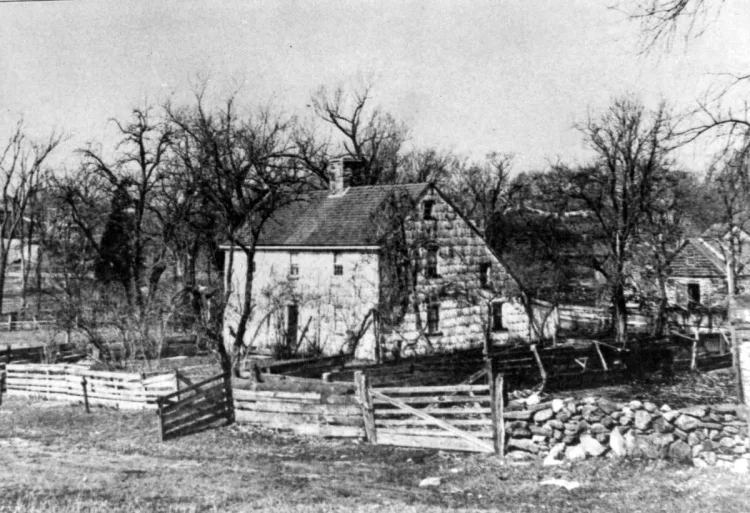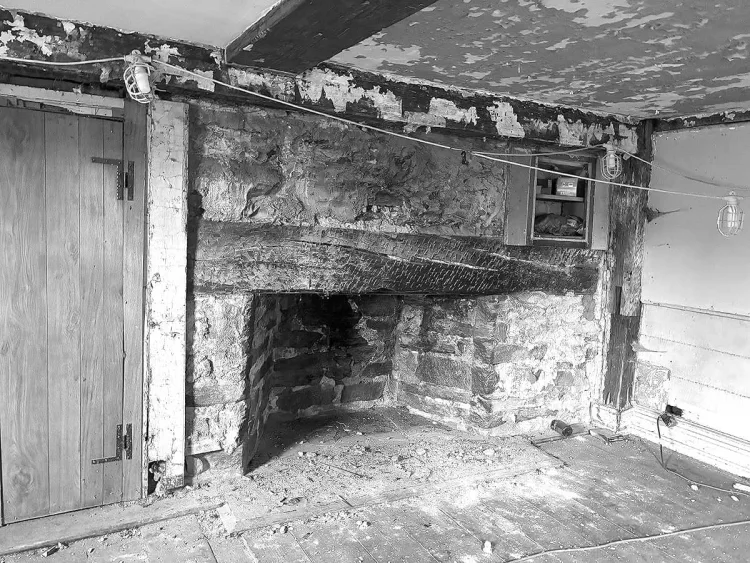The Oral History Project – Celebrating America 250
Greenwich OHP Blog – The Thomas Lyon House

By Mary A. Jacobson
The Thomas Lyon House, built by Thomas Lyon the 2nd in 1695, is the second oldest house in Greenwich and bears witness to the statement: “Greenwich History is American History.” The house may easily be overlooked by the thousands of cars that drive by it each day, crossing from Port Chester to Greenwich. On one side of the road, there’s a sign that reads “Greenwich CT Gateway to New England.” Directly opposite, on the corner of Byram Road and West Putnam Avenue, stands a small, brown-shingled house. Hung across the front of it is a large, faded white banner. Ironically, the only words that can easily be deciphered are “This House… Help Us.”
Despite its current condition, the history of the Thomas Lyon House is a proud one. Julie Grey Pollock, a ninth-generation Lyon descendant, was interviewed by Oral History Project volunteer Richard M. Blair in 2010. She had traveled to Greenwich from her home in Alaska at the time, eager to join other family members on a day which was proclaimed Lyon Family Day by Peter Tesei, then First Selectman.
Julie Grey Pollock was anxious to share her knowledge of the Lyon family, and the history of the Thomas Lyon House. “This area was for most of its life a working farm. The lands that the Lyon family worked on were from as many as three hundred acres, to ninety-five acres in my great-grandfather’s (Underhill Lyon) time, to a final piece of eight acres. They had orchards; they raised livestock; they grew crops; they grew hay; they did a lot of trading in apples and making of cider and vinegar, which they traded to New York.”
The Thomas Lyon House was a participant in the American Revolution. As Pollock stated, “I have the (British) cannonball that hit this house during the Revolutionary War…. Most of that generation… were joining the Americans and fighting the British. But their father, Gilbert, was a Tory… So, I think that whole issue of the sons being for the Revolution, and the father being for the British Crown, had to be rather interesting in this house at that time.” As a child, “I thought everyone had a cannonball by their fireplace.”
Pollock elaborated on the Revolutionary War history of the house at a talk she gave at the Bruce Museum for the Greenwich Preservation Trust in 2012 and kindly sent the transcript to the Oral History Project for its records. In her words, “The neighborhood around the Lyon home at Byram Bridge was a highly strategic location between the advances of the British into New England and the Americans’ repeated attempts in 1779 to repel them… The British forces and Continental Army met up and fought several times along this border zone… Repeated forays of the British, including the destruction of homes, barns, crops, ships and churches along the coast disrupted normal life for many months.” Pollock’s grandmother, Julia Lyon Saunders, told her that family lore that included stories of “redcoats hiding behind the rocks across the road from the house.”

Pollock and her family members have preserved many of the artifacts that were essential to life in those times. “We have the spinning wheels that they used for both flax and for wool… We have utensils, we have implements… so that we would have something really solid to contribute to the overall knowledge of the place,” including documents that tell the economic story of the family from “about 1800 until after the Civil War.” Pollock was particularly proud of a desk she possessed called “Uncle Seth’s desk,” belonging to Seth Lyon, born in 1790. He lived in the house, “a prominent person in his time” and was acclaimed for “working with the African Americans who were in a lot of struggles during that period for freedom.”
In the 1920s, a road-widening project of Boston Post Road nearly resulted in the destruction of the house. Funds were raised, “almost $12,000 which was a lot of money in 1926,” to save it by moving it across the road where it now stands. Pollock’s grandparents moved out that year and gave the historic house to the Rotary and Lions clubs in the hopes that “a handsome visitor center and museum to be known as ‘The Gateway to New England’ would be created.”
With the Depression of 1929 and World War II, those hopeful plans for the Thomas Lyon House did not materialize. “My grandmother, I think, felt very down about what had happened to the house. It became a private rental, and it never became the Gateway to New England” as she had hoped. Instead, it became “a maintenance nightmare and a money sink.” In 2007, the Lions Club gave the home to the Town of Greenwich.
The Thomas Lyon House was listed on the National Register of Historic Places in 1977. The Greenwich Preservation Trust, headed by Andrew Melillo, is now seeking to lease the site from the Town of Greenwich. “Hopefully, we will have the lease signed with RTM approval as well as Planning and Zoning approval by December.” With its eventual maintenance and accessibility plan secured, it is hoped that the story of this historic Greenwich home may be preserved and shared with present and future generations. To quote Julie Grey Pollock, “Like old stone walls, old homes have a story to tell.”
The Oral History Project is proud to present blogs derived from its collection of recorded interviews as part of the Project’s celebration of America 250 Greenwich – Greenwich History is American History. The OHP is sponsored by Friends of Greenwich Library. Visit the website at glohistory.org. Interviews may also be read in their entirety or checked out at the main library.
They are also available for purchase by contacting the OHP office. Our narrator’s recollections are personal and have not been subjected to factual scrutiny. Mary Jacobson serves as blog editor.





